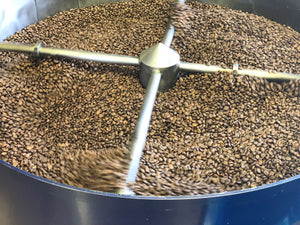Roasting Coffee Part 1: Roast Level
Aug 19, 2019
I’d like to just jump right in to talking about roasting coffee. If you’d like a primer on what happens before the roast process, what we actually receive as a roastery, or what coffee is, go back and read about The Coffee Plant, and The Journey of the Coffee Bean.
Let’s start with the basics: roast level. Desert Sun is a roastery, and hence, we roast coffee. We receive green coffee beans and apply heat to them in our Diedrich coffee roaster. When enough heat has been applied, the beans will come out, roasted and ready for the drinking. How much time the beans spend in the roaster, as well as, to what temperature, determines a specific roast level. Coffee can come as a light roast or a dark roast or anywhere in between. Light roast and dark roast refer to the temperature which a coffee was roasted to. For example, at Desert Sun, our light roast coffees finish around 425 degrees and our darkest roast at 455 degrees. It’s pretty amazing that 30 degrees and a few minutes in the roaster can make such a big difference for the coffee’s taste.
I sometimes hear the question: Which is better? Well, it really comes down to preference. Sort of like if you prefer coke over sprite or vice versa. Do you like a light roast or a dark roast? Learning about coffee roasts can help you know how to make choices that you will enjoy. The more appropriate question here is what does each have to offer?
Light roasts tend to maintain more acidity in the cup. According to The Coffee Cuppers Handbook, acidity “refers to a primary taste sensation related to the presence of sweet-tasting compounds. Created as acids in the coffee combine with sugars to increase the brew’s overall sweetness.” They tend to not have as much body. Light roasts are enjoyed for their ability to allow the flavor of the bean to come through clearly and reveal specific nuances that are distinctive of a country’s origin; such as apricot or berries.
Dark roasts are known for their bold flavor and body. Their higher roast temperature will mellow out the bright flavors that a light roast offers and can reveal dark chocolate notes and creamy mouthfeel. I would say that dark roasts offer a taste that people can consider “comfortable”. The roasty boldness of a dark roast is familiar to many coffee drinkers, whereas, a light roast can be exotically fruity.
I haven’t talked about medium roasts yet but sometimes they are the happy middle ground that someone is looking for. They can reveal many of the characteristics of origin while still offering a bold and sweet cup with a lot of depth.
My preference is a light to medium roast. I’ll drink a light roast Ethiopia if I’m in the mood for a sweet cup that offers hints of berries, or a slightly darker, yet still light, Colombia for cheery notes combined with some dark chocolate roastiness. Maybe even an earthy medium roast in the afternoon from Sumatra. What can I say? I’m a fan of the nuances that exist from the soil and weather from where the beans were grown. But this is just my preference and I encourage you to openly try different types and chose for yourself. Even if you like your coffee with cream and sugar, I’d encourage you to take a sip of your coffee black, before you add them, and notice why it is that you like the type of roast you have chosen and what flavors and tastes it has to offer.
I’d like to talk more about roasting so there will be another part to this where I’ll get into more technical details of what happens in the roast process. Thanks for reading.
~ZacharyRay~

